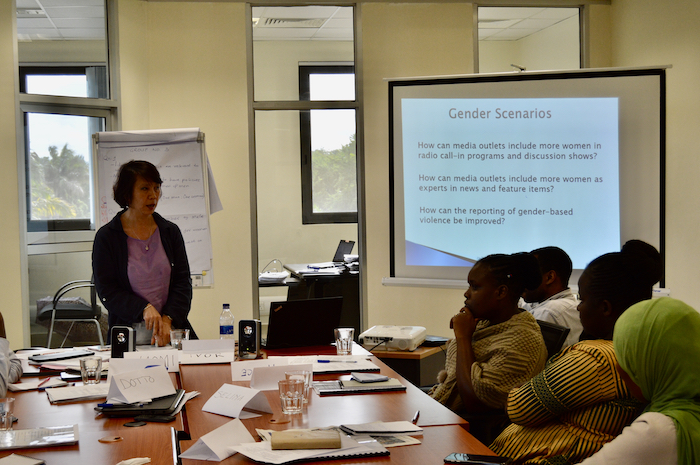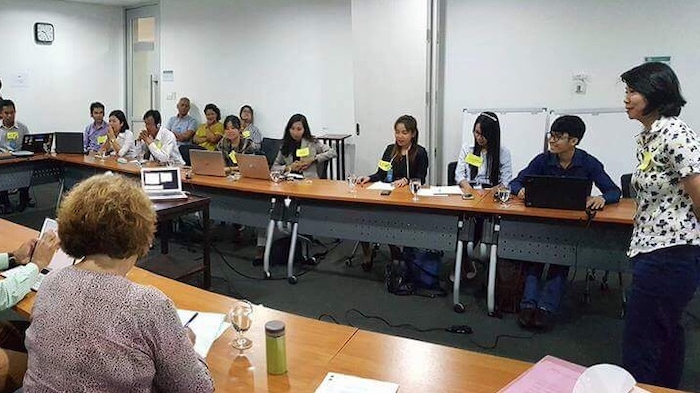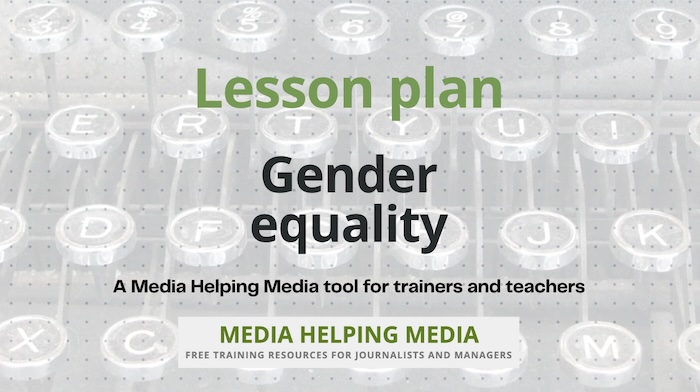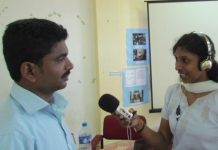
The role of the journalist in rectifying gender imbalance in media is multifaceted, and it involves both individual actions and contributing to broader systemic change.
The number of women and men in the world is roughly equal according to data compiled in 2021. However women make up about a quarter of those heard, read about or seen in news output. And only one in five experts interviewed by journalists are women.
To find out why, and what can be done about it, we first need to consider the difference between gender and sex.
Sex refers to biological differences between men and women. Men produce sperm and women can become pregnant, bear children and breastfeed. These differences are permanent without surgery and medicine.
Gender refers to socially constructed differences between women and men. These differences are not biological and are therefore fluid. They vary between cultures, within cultures, and over time. This affects how we are seen and how we are expected to behave as men and women.
Media can play an important role in either promoting gender equality or perpetuating gender stereotypes.
Women make up half the population and therefore make up half the audience so it doesn’t make sense to pay them less attention. They make decisions on behalf of themselves, their families and their businesses or organisations. They also possess half the potential of the global population.
Women are customers. They buy goods and services for themselves. They are business owners and householders so they are attractive to advertisers and other businesses. It makes no financial sense to underestimate women in any media business plan.
But, despite this, the portrayal of women in the media is often far from accurate. The media needs to ensure it offers proportional and fair coverage of women rather than resorting to using outdated stereotypes.
According to UNESCO Institute for Statistics (2018) more than half of all scientists in Thailand are women. STEM (Science, Technology, Engineering and Mathematics) subjects that have traditionally been seen as a male area of expertise and so this is an impressive achievement. However, a 2015 UNESCO study found that women are more likely to be depicted as victims, family members and sex objects in the media throughout Asia.
Journalists who use such stereotypes in their coverage are failing in one of the core values of journalism – accuracy.
Take a look at any mainstream media organisation and consider how women and girls are portrayed. Check how often women are interviewed as experts in their field. Assess how often women are portrayed as victims.
In children’s cartoons, films and stories observe how girls and boys are depicted and consider what influence this might have on children and their parents.
It is possible you will notice gender bias. This is why gender equality is important. Journalists and media organisations can address this.
When a speaker is needed for an opinion on an issue ensure that half those selected are women. To be an expert a person doesn’t necessarily need to have an academic qualification. Traditionally, women have carried out unpaid work but through that work they become experts in that field.
Media managers can ensure that recruitment is gender blind. They can ask someone in the organisation who is not connected with the selection process to present job applicant’s CVs and covering letters without reference to their gender or identities. This prevents candidates being judged unfairly by their names at the early stage. Some names are an indication of ethnicity or social background.
Human resources (HR) managers should ensure that there is a balance of genders in all sections of a media organisation, including technical roles, senior editorial positions, board members and owners. However there isn’t much HR can do about ownership
Women should be paid the same as men for performing similar duties. In some organisations women do similar work as men and yet are paid less. In 2017, the BBC was found to be paying the top rates of pay to twice as many male presenters as they were to their female presenters. The UK’s Equality and Human Rights Commission did not find any unlawful acts of pay discrimination but the corporation was told to have greater transparency and rebuild trust with women who work there. However, following some high-profile complaints of unfair pay between men and women, 700 female staff received pay rises.
Women can face additional pressures such as online harassment as a result of their media work. This can include threats of violence and sexual insults. Media managers need to be aware of this and work with both female and male staff to introduce safeguarding measures.
Introducing gender equality in a media workplace is not difficult. There are a number of simple questions journalists and media managers need to address.
In programme output, do women appear as knowledgeable and empowered or are they in passive roles as victims? Do they exist only in their relation to a man? Do the concerns and interests of women receive half the attention as those of men?
When the opinions of a business owner or farmer are needed for a story don’t always turn to a man. Similarly, a caregiver can be male.
Are the questions the same? Are female politicians, activists and experts asked different questions to the ones asked of men in these positions? When do you hear male interviewees being asked how they manage to cope with juggling a career with raising children?
Are men and women depicted according to their gender or for the story? Are male interviewees photographed or filmed in the same way as female interviewees?
Consider the language used in scripts and introductions. Use camera operator instead of cameraman or camerawoman. police officer instead of policeman or policewoman. Humankind instead of mankind. This puts the job or role ahead of the gender and prevents the lazy assumption that the job or role is carried out by a man.
Some languages are more gendered than others and often the default is that the masculine is predominant. For example, in Spanish – a male friend is amigo and a female friend is amiga, but a group of friends takes the masculine and is amigos. You might wonder if this difference has an impact on society’s attitude to gender. It is worth noting that languages are always evolving, just like our views of gender.

Summary
Gender equality is important for both men and women. Neither gender benefits from being stereotyped and not being allowed to fulfil its full potential.
- Take steps to ensure that women are represented in all roles and at all levels in your media organisation and that they are paid the same for doing the same work.
- Is the workplace comfortable for both women and men? Find solutions for dealing with sexual harassment in the workplace and online.
- Avoid stereotyping when presenting men and women in your content.
- Make your language as gender-inclusive as possible.
- Be aware of and address cases where unconscious bias is affecting your output.
All our communities benefit when individual differences are welcomed and everyone – regardless of their gender – can play a full role in their society and are not expected to fill certain predetermined roles.
Every media organisation needs to provide gender equality training for all staff, regardless of their gender. Such training needs to filter through every level of the organisation from senior managers to interns on work experience. It needs to be part of the core values of the organisation and the policy should be visible in everything that is produced.
By Naomi Goldsmith
 Despite progress in many areas, the news industry continues to struggle with gender equality. Women remain underrepresented in newsrooms, particularly in leadership roles, and their voices are often marginalised in news coverage.
Despite progress in many areas, the news industry continues to struggle with gender equality. Women remain underrepresented in newsrooms, particularly in leadership roles, and their voices are often marginalised in news coverage.
This imbalance has significant implications for the quality and diversity of information that shapes public discourse.
One of the most pressing issues is the lack of women in decision-making positions. Despite making up a significant portion of journalism graduates, women are still underrepresented in top editorial roles.
This disparity affects not only the career trajectories of female journalists but also the kinds of stories that are prioritised and how they are framed.
Even when women are present in newsrooms, their voices are often sidelined in news coverage. Studies have shown that female sources are quoted far less frequently than male sources, and women are often relegated to covering “soft” news topics such as lifestyle and entertainment, while men dominate coverage of politics, economics, and international affairs.
This gender imbalance in news has several consequences. It perpetuates harmful stereotypes, limits the diversity of perspectives, and ultimately undermines the credibility of news organisations.
When women’s voices are excluded or marginalised, important stories go untold, and the public is left with an incomplete understanding of the world.
However, there are reasons to be optimistic. In recent years, there has been a growing awareness of the need for greater gender equality in news.
Organisations such as the International Women’s Media Foundation and the Women’s Media Center are working to support female journalists and promote their work. There are also increasing calls for newsrooms to implement policies that promote diversity and inclusion.
The rise of digital media has created new opportunities for women to share their stories and perspectives. Independent news outlets and online platforms are providing spaces for women to report on issues that are often ignored by mainstream media.
Gender equality in news is not just a women’s issue – it is a matter of fairness, accuracy, and the pursuit of a more informed and just society.

Questions
- What is the difference between sex and gender?
- According to Naomi’s article, what percentage of experts interviewed by journalists are women?
- How does the media influence gender equality or perpetuate gender stereotypes?
- Why is it financially beneficial for media businesses to accurately represent women?
- What role do journalists play in addressing gender bias in media coverage?
- How does the portrayal of women in STEM (Science, Technology, Engineering and Mathematics) skills in Thailand contrast with their depiction in media throughout Asia?
- What measures can media managers take to ensure gender equality in recruitment?
- How does Naomi’s article suggest addressing pay disparities between men and women in media organisations?
- What are some of the additional pressures women face in media work, according to the article?
- How can language use in media contribute to gender inclusivity?
Answers
- Sex refers to biological differences, while gender refers to socially constructed differences that are fluid and vary across cultures and time.
- Only 20% (one in five) of experts interviewed by journalists are women (2022)
- The media can either promote gender equality or perpetuate stereotypes by how it portrays women and men, influencing societal perceptions and expectations.
- Women make up half the population and audience, influencing purchasing decisions and possessing significant potential, making them valuable to advertisers and businesses.
- Journalists can address gender bias by ensuring fair and accurate representation of women, avoiding stereotypes, and selecting diverse experts for interviews.
- In Thailand, over half of scientists are women, yet media in Asia often depicts women as victims or in stereotypical roles, highlighting a disparity.
- Media managers can ensure gender-blind recruitment by anonymising CVs and cover letters to prevent bias based on gender or identity.
- The text suggests ensuring equal pay for similar work and increasing transparency, as seen in the BBC’s response to pay disparities.
- Women in media face online harassment, including threats and insults, necessitating safeguarding measures by media managers.
- Using gender-neutral language, such as “camera operator” instead of “cameraman,” helps prevent assumptions and promotes inclusivity.
Lesson plan for trainers
If you are a trainer of journalists we have a free Lesson plan: Gender equality in the media which you are welcome to download and adapt for your own purposes.









